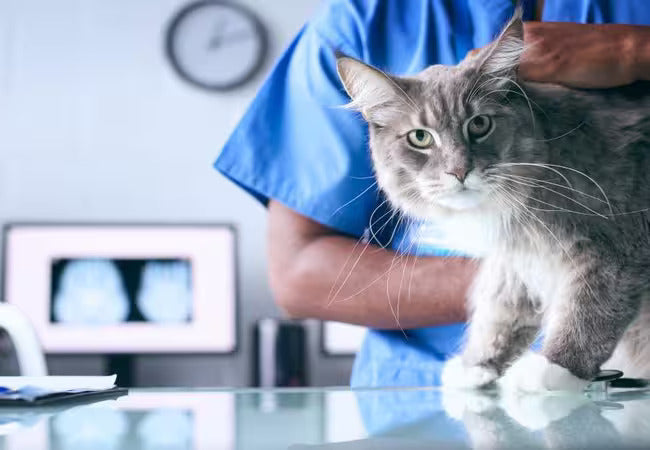Vet‑Approved 2025 Guide: Cystotomy in Cats – When, How & Recovery Care 🐱💉

In this article
Vet‑Approved 2025 Guide: Cystotomy in Cats – When, How & Recovery Care 🐱💉
By Dr. Duncan Houston BVSc
A cystotomy is a surgical procedure in which the bladder is opened to address issues like bladder stones, tumors, resistant infections, or trauma. In cats, this procedure is often lifesaving—especially when obstructions risk bladder rupture or kidney damage. In this 2025 vet‑approved article by Dr. Duncan Houston BVSc, we dive into indications, surgical methods, costs, recovery protocols, potential issues, and how to enrich your cat’s recovery with tools from Ask A Vet, 🐾🐱
🔍 Why a Cystotomy May Be Needed
Common reasons include:
- Bladder or urethral stones cause painful obstruction and urinary retention.
- Bladder tumors—especially to obtain tissue samples or remove masses.
- Persistent urinary tract infections are not responsive to antibiotics.
- Traumatic injury to the bladder or ureters (e.g., car accident).
- Significant crystal or debris accumulation leading to blockage.
Left untreated, these issues can escalate to bladder rupture, infections, or damage to the kidneys. Prompt surgery is often critical when your cat cannot urinate normally. 🚨
📋 Diagnostic Work-Up Before Surgery
Before recommending cystotomy, veterinarians typically perform:
- Blood tests and urinalysis to check organ function and infection {{}}
- X‑rays or ultrasound to visualize stones, masses, or trauma.
- Urine culture if infection is suspected to guide antibiotic choice.
Once a surgical need is confirmed, bloodwork is repeated pre-op to ensure your cat is healthy enough for anesthesia and the procedure. 💉
🔧 Step-by-Step Procedure
- Preparation: General anesthesia, clipping, and sterile prep of the abdominal area.
- Abdominal entry: Midline incision through skin and abdominal wall to access the bladder.
- Bladder incision: A small cut is made into the bladder to remove stones, masses, debris, or damaged tissue.
- Bladder inspection: Lining is checked thoroughly; samples may be taken for biopsy or culture.
- Suture closure: The bladder is closed with absorbable sutures, then the abdomen is thoroughly flushed to prevent leakage; abdominal wall and skin are closed in layers.
- Catheter placement: A temporary urinary catheter helps monitor urination and bladder function post-op.
💰 Cost & Hospital Stay
- Estimated cost: Typically between $2,000–4,500, including diagnostics, anesthesia, surgery, hospital stay, and medications.
- Hospital time: Usually 2–3 days for monitoring urination, pain control, and IV fluids.
🩺 Postoperative Care
- ✔️ Pain medication—NSAIDs or opioids prescribed for 7–14 days.
- ✔️ Antibiotics if infection was present or samples were taken.
- ✔️ Urinary catheter monitored until normal urination resumes.
- ✔️ Short periods of crate rest to limit activity and facilitate healing.
- ✔️ Daily incision checks—monitor for redness, swelling, or discharge.
- ✔️ Recheck appointments around days 7–10 for suture evaluation and further guidance.
⚠️ Potential Complications
- Post-op infection—monitor warm/red incision, discharge, or fever.
- Urine leakage—could lead to peritonitis if bladder closure leaks.
- Reocclusion—stones forming again or incomplete removal.
- Fistula or narrowing—rare but may affect urinary flow.
If you notice any complications, contact your veterinarian immediately. 🆘
🏡 Recovery & Home Enrichment
Help your cat heal smoothly by combining restful care with gentle mental stimulation:
- Provide quiet, soft bedding and easy access to litter.
- Use gentle food puzzles or lick mats to stimulate appetite and distract gently.
- Short supervised time in new areas for scent exploration fosters mental wellness.
- Schedule a remote consult via Ask A Vet to discuss healing progress and next steps safely from home.
📆 Timeline to Normalcy
- Days 1–3: Focus on pain control, monitoring urination, and minor crate rest.
- Weeks 1–2: Gradually reduce activity; monitor healing. Food puzzles and soft interaction are ideal.
- Weeks 2–4: Incision fully heals; increasing gentle activity and vet approval required.
- Month 2+: Cat gradually resumes regular activity. Recheck is recommended at 4–6 weeks post-op.
✅ Owners’ Action Plan
- Ensure follow-up visits for suture evaluation and progress check.
- Provide fresh water, diet adjustments, and monitor litter-box habits.
- Observe for changes—straining, behavior, appetite—as potential signs of concern.
- Use calming aids and mental enrichment to support comfort and healing.
🏁 Final Thoughts
Cystotomy is a vital procedure that saves lives by addressing painful or dangerous urinary issues in cats. With modern surgical methods, expert monitoring, and supportive recovery tools from Ask A Vet, your cat can heal fully and return to a high-quality life. Stay observant, follow post-op guidance closely, and lean on virtual support when needed. 🐱❤️
If you'd like help interpreting post-op behavior, remote monitoring, or confidence in your cat’s recovery—visit Ask A Vet or use the app today! 🐾✨






